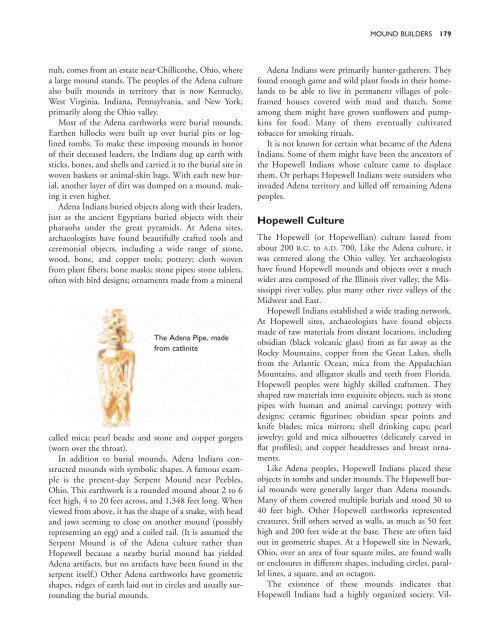You also want an ePaper? Increase the reach of your titles
YUMPU automatically turns print PDFs into web optimized ePapers that Google loves.
MOUND BUILDERS 179<br />
nuh, comes from an estate near Chillicothe, Ohio, where<br />
a large mound stands. The peoples <strong>of</strong> the Adena culture<br />
also built mounds in territory that is now Kentucky,<br />
West Virginia, Indiana, Pennsylvania, and New York,<br />
primarily along the Ohio valley.<br />
Most <strong>of</strong> the Adena earthworks were burial mounds.<br />
Earthen hillocks were built up over burial pits or loglined<br />
tombs. To make these imposing mounds in honor<br />
<strong>of</strong> their deceased leaders, the Indians dug up earth with<br />
sticks, bones, and shells and carried it to the burial site in<br />
woven baskets or animal-skin bags. With each new burial,<br />
another layer <strong>of</strong> dirt was dumped on a mound, making<br />
it even higher.<br />
Adena Indians buried objects along with their leaders,<br />
just as the ancient Egyptians buried objects with their<br />
pharaohs under the great pyramids. At Adena sites,<br />
archaeologists have found beautifully crafted tools and<br />
ceremonial objects, including a wide range <strong>of</strong> stone,<br />
wood, bone, and copper tools; pottery; cloth woven<br />
from plant fibers; bone masks; stone pipes; stone tablets,<br />
<strong>of</strong>ten with bird designs; ornaments made from a mineral<br />
The Adena Pipe, made<br />
from catlinite<br />
called mica; pearl beads; and stone and copper gorgets<br />
(worn over the throat).<br />
In addition to burial mounds, Adena Indians constructed<br />
mounds with symbolic shapes. A famous example<br />
is the present-day Serpent Mound near Peebles,<br />
Ohio. This earthwork is a rounded mound about 2 to 6<br />
feet high, 4 to 20 feet across, and 1,348 feet long. When<br />
viewed from above, it has the shape <strong>of</strong> a snake, with head<br />
and jaws seeming to close on another mound (possibly<br />
representing an egg) and a coiled tail. (It is assumed the<br />
Serpent Mound is <strong>of</strong> the Adena culture rather than<br />
Hopewell because a nearby burial mound has yielded<br />
Adena artifacts, but no artifacts have been found in the<br />
serpent itself.) Other Adena earthworks have geometric<br />
shapes, ridges <strong>of</strong> earth laid out in circles and usually surrounding<br />
the burial mounds.<br />
Adena Indians were primarily hunter-gatherers. They<br />
found enough game and wild plant foods in their homelands<br />
to be able to live in permanent villages <strong>of</strong> poleframed<br />
houses covered with mud and thatch. Some<br />
among them might have grown sunflowers and pumpkins<br />
for food. Many <strong>of</strong> them eventually cultivated<br />
tobacco for smoking rituals.<br />
It is not known for certain what became <strong>of</strong> the Adena<br />
Indians. Some <strong>of</strong> them might have been the ancestors <strong>of</strong><br />
the Hopewell Indians whose culture came to displace<br />
them. Or perhaps Hopewell Indians were outsiders who<br />
invaded Adena territory and killed <strong>of</strong>f remaining Adena<br />
peoples.<br />
Hopewell Culture<br />
The Hopewell (or Hopewellian) culture lasted from<br />
about 200 B.C. to A.D. 700. Like the Adena culture, it<br />
was centered along the Ohio valley. Yet archaeologists<br />
have found Hopewell mounds and objects over a much<br />
wider area composed <strong>of</strong> the Illinois river valley, the Mississippi<br />
river valley, plus many other river valleys <strong>of</strong> the<br />
Midwest and East.<br />
Hopewell Indians established a wide trading network.<br />
At Hopewell sites, archaeologists have found objects<br />
made <strong>of</strong> raw materials from distant locations, including<br />
obsidian (black volcanic glass) from as far away as the<br />
Rocky Mountains, copper from the Great Lakes, shells<br />
from the Atlantic Ocean, mica from the Appalachian<br />
Mountains, and alligator skulls and teeth from Florida.<br />
Hopewell peoples were highly skilled craftsmen. They<br />
shaped raw materials into exquisite objects, such as stone<br />
pipes with human and animal carvings; pottery with<br />
designs; ceramic figurines; obsidian spear points and<br />
knife blades; mica mirrors; shell drinking cups; pearl<br />
jewelry; gold and mica silhouettes (delicately carved in<br />
flat pr<strong>of</strong>iles); and copper headdresses and breast ornaments.<br />
Like Adena peoples, Hopewell Indians placed these<br />
objects in tombs and under mounds. The Hopewell burial<br />
mounds were generally larger than Adena mounds.<br />
Many <strong>of</strong> them covered multiple burials and stood 30 to<br />
40 feet high. Other Hopewell earthworks represented<br />
creatures. Still others served as walls, as much as 50 feet<br />
high and 200 feet wide at the base. These are <strong>of</strong>ten laid<br />
out in geometric shapes. At a Hopewell site in Newark,<br />
Ohio, over an area <strong>of</strong> four square miles, are found walls<br />
or enclosures in different shapes, including circles, parallel<br />
lines, a square, and an octagon.<br />
The existence <strong>of</strong> these mounds indicates that<br />
Hopewell Indians had a highly organized society. Vil-


















